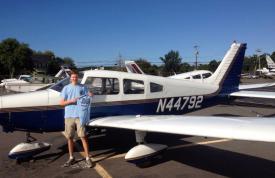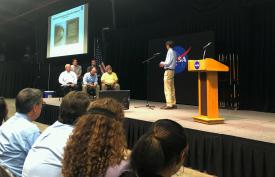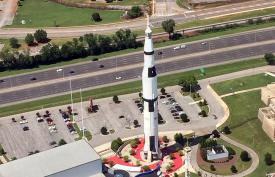Since I was young, I have always had a fascination with flight. For a time, I even wanted to be an astronaut (ok, I still do). In high school I was fortunate to have the opportunity to work in the aircraft maintenance shop of a local airport and take flight lessons—I was able to say I flew a plane before I could drive a car! Flying is an experience like no other. From my first time in a small plane seeing the trees drop away as the plane climbed during takeoff, I became hooked. On a clear day, I could often see the ocean, New York, and Philadelphia at the same time. During my time in the maintenance shop, I also became familiar with some of the inner workings of aircraft and developed an appreciation for all the systems that must function for a plane to fly, leading me closer to eventually pursuing mechanical and aerospace engineering in college.
At Rutgers, I knew I had to continue pursuing this interest and quickly joined the AIAA, a club focused on aerospace related engineering competitions. AIAA allowed me to meet and grow close to many like-minded students and to participate in the AUVSI sUAS competition, which challenges students to design and build a plane capable of autonomous flight over a search area and autonomous recognition of targets. AIAA also gave me leadership opportunities—I was the treasurer during my junior year and will serve as president in my senior year this fall. In addition to AIAA, I also participated in research as an undergrad working on In-Space Additive Manufacturing in Dr. Mazzeo’s lab after attending a talk at the Honors College sponsored by Dr. Mazzeo, which featured a NASA engineer.
From my experience in the lab, I was able to participate in an internship further researching In-Space Additive Manufacturing at NASA’s Marshall Space Flight Center in Huntsville, AL. This year I again am interning at Marshall working on structural health monitoring and capacitive sensing —technology which may one day be used for deep space habitats as well as applications on the ground. Work includes developing sensors to measure force and detect leaks, then incorporating the data into a computer program in real time. During the internship, I participated in Marshall's "Tech Tank" competition. From more than 30 submissions from civil servants, contractors, and other interns, I was among 14 selected to present my project to several judges, including special guest Mark Cuban of the popular television show Shark Tank. I ended up receiving $10,000 in funding from NASA for supplies for the project.
At Marshall, I have been able to meet many scientists and engineers involved in the Space Launch System program and other important projects. I am still in awe of being at the location of many important engineering feats, including design and testing of the Redstone Missile, Saturn V and Space Shuttle. I hope to continue in the aerospace field by pursuing graduate school and eventually working full time as a civil servant for NASA or for a contractor. I am grateful for the opportunities Rutgers has given me in the aerospace field, from AIAA to working in the lab and getting connected to NASA.


